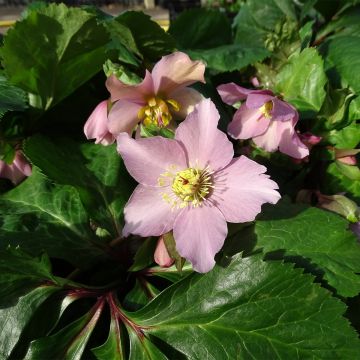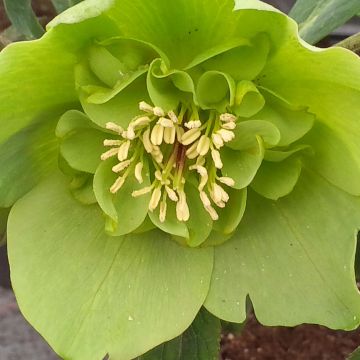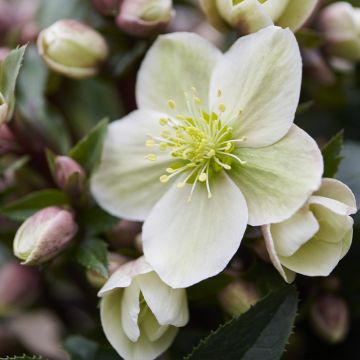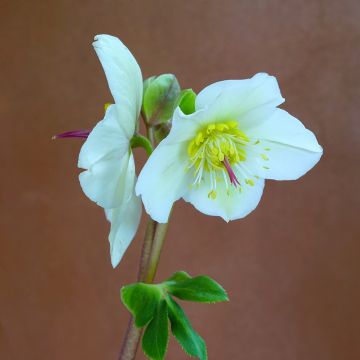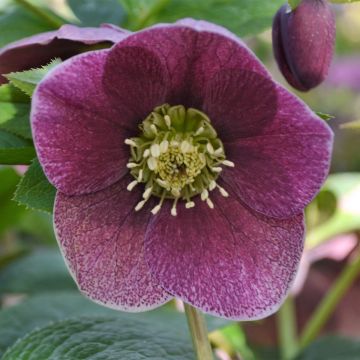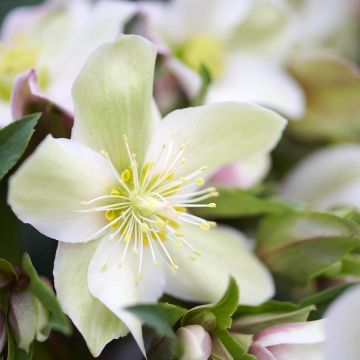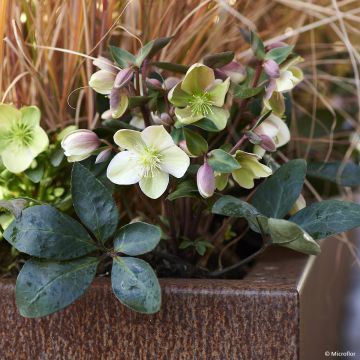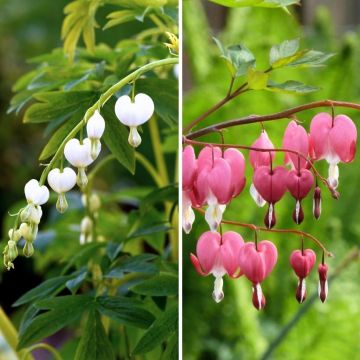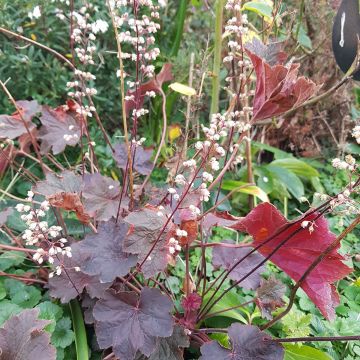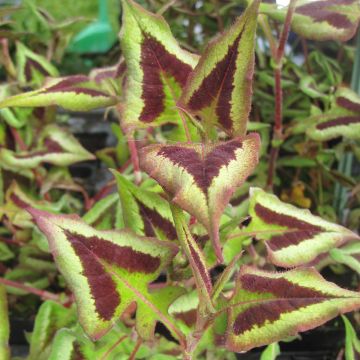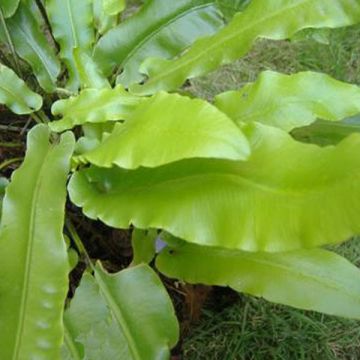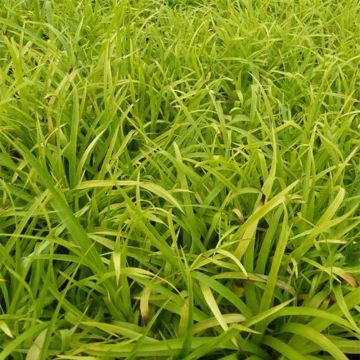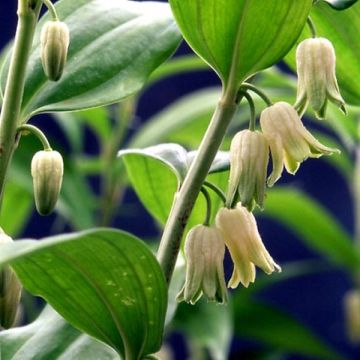

Helleborus HGC Lenia


Helleborus HGC Lenia
Helleborus HGC Lenia
Helleborus x lemperii HGC® Lenia
Christmas Rose, Hybrid Hellebore
My hellebore started flowering 2 weeks after being planted, and has bloomed all winter. It's starting to fade now, on 6th April, but honestly, it's a very beautiful flower and I'm delighted.
Corinne, 06/04/2023
Special offer!
Receive a €20 voucher for any order over €90 (excluding delivery costs, credit notes, and plastic-free options)!
1- Add your favorite plants to your cart.
2- Once you have reached €90, confirm your order (you can even choose the delivery date!).
3- As soon as your order is shipped, you will receive an email containing your voucher code, valid for 3 months (90 days).
Your voucher is unique and can only be used once, for any order with a minimum value of €20, excluding delivery costs.
Can be combined with other current offers, non-divisible and non-refundable.
Why not try an alternative variety in stock?
View all →This plant carries a 12 months recovery warranty
More information
We guarantee the quality of our plants for a full growing cycle, and will replace at our expense any plant that fails to recover under normal climatic and planting conditions.
Would this plant suit my garden?
Set up your Plantfit profile →
Description
Lenia is a variety of Hellebore obtained by cross-breeding between the Christmas Rose and another species of Hellebore. This perennial plant has long-lasting flowering, from mid-November to spring. Beautiful flowers of a deep purple-pink, enhanced by a heart of yellow stamens, stand tall and visible above the foliage. The dark green, evergreen leaves are deeply cut, and artistically interesting, forming a compact, decorative clump all year round. This hardy Hellebore will thrive in the garden, in a shady bed, as well as in a pot on a balcony or terrace.
Hellebore is a member of the Ranunculaceae family, which includes about sixty genera and around 2500 species. Many of them are poisonous and contain substances which are toxic if ingested, a natural protection to prevent them from being grazed by herbivores. The Helleborus genus includes about twenty species, some of which have been crossed to create new plants. Helleborus x lemperii is a hybrid (hence the x between the genus name and the species name) obtained by fertilization between H. niger, the Christmas Rose, and H. x hybridus, a cross-breeding that was considered impossible until a few years ago. The German company Heuger, located in Glandorf, Lower Saxony, has distinguished itself by launching the HGC range (Helleborus Gold Collection), characterized by good cold resistance, particularly large flowers carried by strong stems, an extended flowering period and a good ability to be grown in pots.
Hellobore Lenia benefits from all these qualities and will delight enthusiasts of contrasting and colourful flowers. The large single corollas with 5 petals form a flared cup of a deep purple-pink, enhanced by the yellow stamens that emerge from the centre. The first flowers appear around mid-November and buds continue to appear until March-April. These flowers make magnificent winter bouquets and will be the main focal point in a mixed flower bed. Carried by sturdy stems, the single corollas rise above the dark foliage, which serves as a backdrop, clearly visible from a distance. The large flowers bloom vertically, as is the case with most Hellebore varieties. They can even slightly tilt downwards, allowing water to slide off like an umbrella, avoiding accumulation in the centre that could cause rotting. The foliage consists of palmate, slightly toothed, dark green and shiny, evergreen basal leaves which actually only live for 8 months and are regularly replaced by new leaves. This Hellebore forms a compact clump about 45 cm (18in) in height and width.
Hellebore Lenia is perfectly suited for pot cultivation to enhance a terrace or balcony where it will create a superb flowering pot. You can also create a composition of evergreens in a large container by pairing it with other perennials or dwarf shrubs, such as Euonymus japonicus Happiness, a miniature Spindle tree with golden yellow young shoots. This perennial will thrive under a leafy tree that allows winter sun to pass through but protects it from intense summer sun. You can also plant it in a more shaded area. Hellebores are essential for winter flowering in the garden. The multitude of varieties with varied colours and single or double flowers could be enough to fill a flower bed, but it is better to associate them with other plants to ensure year-round flowering. Hellebores are a must-have for winter flowers in the garden. The Anemone japonica will offer its charming flowers from August to October, belonging to the same plant family as Hellebores, they share the same cultural affinities. Astrantias will bloom during the summer, such as the beautiful Astrantia major Hadspen Blood with a colour similar to Lenia's and also a very good cut flower. Earlier in the season, the classic Bleeding Heart, or Dicentra spectabilis, is always charming with its pink flowers with white tips arranged like the beads of a rosary. And for spring, succumb to the charm of Epimedium, rich in numerous varieties, all as attractive as each other, with their delicate flowers in multiple colours in spring.
Report an error about the product description
Helleborus HGC Lenia in pictures
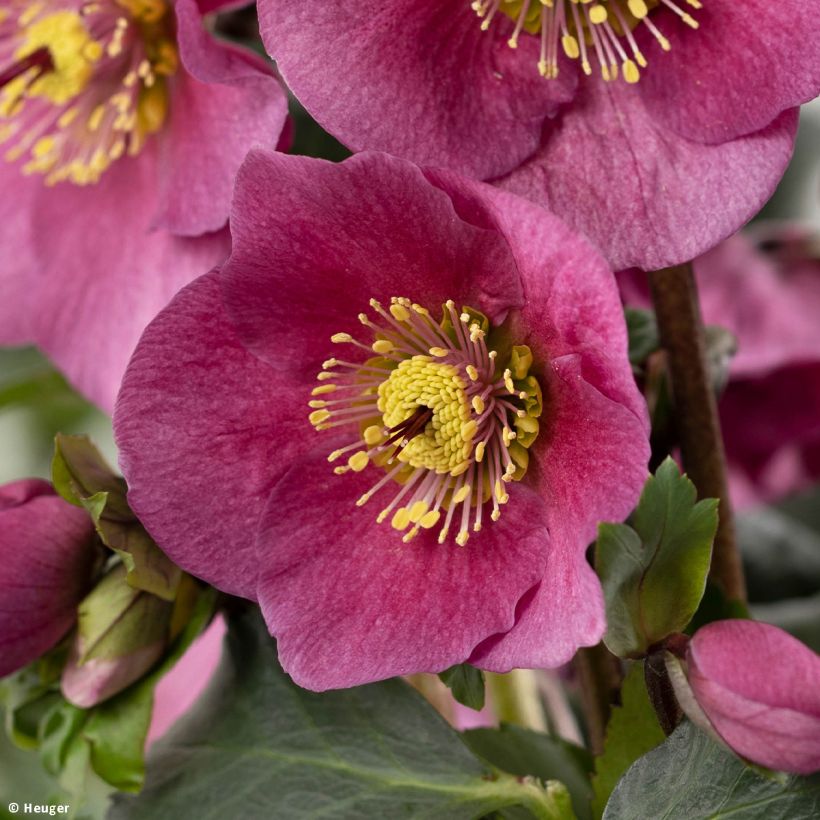

Flowering
Foliage
Plant habit
Safety measures
Botanical data
Helleborus
x lemperii
HGC® Lenia
Ranunculaceae
Christmas Rose, Hybrid Hellebore
Cultivar or hybrid
ingestion
Cette plante est toxique si elle est ingérée volontairement ou involontairement.
Ne la plantez pas là où de jeunes enfants peuvent évoluer, et lavez-vous les mains après l'avoir manipulée.
Pensez à conserver l'étiquette de la plante, à la photographier ou à noter son nom, afin de faciliter le travail des professionnels de santé.
Davantage d'informations sur https://plantes-risque.info
Planting and care
Hellebore grows in any deep, rich, light or clayey soil, even limestone, in partial or light shade, sheltered from cold and dominant winds. Avoid direct sunlight during the hottest hours in the south. This perennial is planted from early autumn to spring, avoiding frost. It thrives in deeply worked soil mixed with organic matter. Water well after planting and add a layer of mulch 2 to 5 cm (1 to 2in) thick. Regularly remove faded flowers to improve flowering. Make sure to plant them with a distance of 30 to 40 cm (12 to 16in) between each plant to promote their development. Hellebore does not tolerate stagnant water as it may cause it to rot. From the second year after planting, feed in February and then in the middle of summer when the plant produces new roots and initiates future flower buds. Use organic fertilizers containing equal amounts of potassium and nitrogen to avoid creating an imbalance.
The roots should not completely dry out in summer. Hellebores can be affected by a fungal disease transmitted by aphids, known as black spot. Remove the spotted leaves when the flower buds appear. Remove faded flowers after the seeds have fallen. They can also suffer from grey rot or die from collar rot due to poor growing conditions, in overly moist situations.
On a balcony or terrace, plant them in pots that are significantly larger than they are, as they need space to develop their root system. This hardy Hellebore can withstand freezing temperatures down to -23°C (-9.4°F) without suffering, allowing it to adapt to all regions. Hellebores are low-maintenance plants that can live for many years without requiring much care.
Planting period
Intended location
Care
-
, onOrder confirmed
Reply from on Promesse de fleurs
Similar products
Haven't found what you were looking for?
Hardiness is the lowest winter temperature a plant can endure without suffering serious damage or even dying. However, hardiness is affected by location (a sheltered area, such as a patio), protection (winter cover) and soil type (hardiness is improved by well-drained soil).

Photo Sharing Terms & Conditions
In order to encourage gardeners to interact and share their experiences, Promesse de fleurs offers various media enabling content to be uploaded onto its Site - in particular via the ‘Photo sharing’ module.
The User agrees to refrain from:
- Posting any content that is illegal, prejudicial, insulting, racist, inciteful to hatred, revisionist, contrary to public decency, that infringes on privacy or on the privacy rights of third parties, in particular the publicity rights of persons and goods, intellectual property rights, or the right to privacy.
- Submitting content on behalf of a third party;
- Impersonate the identity of a third party and/or publish any personal information about a third party;
In general, the User undertakes to refrain from any unethical behaviour.
All Content (in particular text, comments, files, images, photos, videos, creative works, etc.), which may be subject to property or intellectual property rights, image or other private rights, shall remain the property of the User, subject to the limited rights granted by the terms of the licence granted by Promesse de fleurs as stated below. Users are at liberty to publish or not to publish such Content on the Site, notably via the ‘Photo Sharing’ facility, and accept that this Content shall be made public and freely accessible, notably on the Internet.
Users further acknowledge, undertake to have ,and guarantee that they hold all necessary rights and permissions to publish such material on the Site, in particular with regard to the legislation in force pertaining to any privacy, property, intellectual property, image, or contractual rights, or rights of any other nature. By publishing such Content on the Site, Users acknowledge accepting full liability as publishers of the Content within the meaning of the law, and grant Promesse de fleurs, free of charge, an inclusive, worldwide licence for the said Content for the entire duration of its publication, including all reproduction, representation, up/downloading, displaying, performing, transmission, and storage rights.
Users also grant permission for their name to be linked to the Content and accept that this link may not always be made available.
By engaging in posting material, Users consent to their Content becoming automatically accessible on the Internet, in particular on other sites and/or blogs and/or web pages of the Promesse de fleurs site, including in particular social pages and the Promesse de fleurs catalogue.
Users may secure the removal of entrusted content free of charge by issuing a simple request via our contact form.
The flowering period indicated on our website applies to countries and regions located in USDA zone 8 (France, the United Kingdom, Ireland, the Netherlands, etc.)
It will vary according to where you live:
- In zones 9 to 10 (Italy, Spain, Greece, etc.), flowering will occur about 2 to 4 weeks earlier.
- In zones 6 to 7 (Germany, Poland, Slovenia, and lower mountainous regions), flowering will be delayed by 2 to 3 weeks.
- In zone 5 (Central Europe, Scandinavia), blooming will be delayed by 3 to 5 weeks.
In temperate climates, pruning of spring-flowering shrubs (forsythia, spireas, etc.) should be done just after flowering.
Pruning of summer-flowering shrubs (Indian Lilac, Perovskia, etc.) can be done in winter or spring.
In cold regions as well as with frost-sensitive plants, avoid pruning too early when severe frosts may still occur.
The planting period indicated on our website applies to countries and regions located in USDA zone 8 (France, United Kingdom, Ireland, Netherlands).
It will vary according to where you live:
- In Mediterranean zones (Marseille, Madrid, Milan, etc.), autumn and winter are the best planting periods.
- In continental zones (Strasbourg, Munich, Vienna, etc.), delay planting by 2 to 3 weeks in spring and bring it forward by 2 to 4 weeks in autumn.
- In mountainous regions (the Alps, Pyrenees, Carpathians, etc.), it is best to plant in late spring (May-June) or late summer (August-September).
The harvesting period indicated on our website applies to countries and regions in USDA zone 8 (France, England, Ireland, the Netherlands).
In colder areas (Scandinavia, Poland, Austria...) fruit and vegetable harvests are likely to be delayed by 3-4 weeks.
In warmer areas (Italy, Spain, Greece, etc.), harvesting will probably take place earlier, depending on weather conditions.
The sowing periods indicated on our website apply to countries and regions within USDA Zone 8 (France, UK, Ireland, Netherlands).
In colder areas (Scandinavia, Poland, Austria...), delay any outdoor sowing by 3-4 weeks, or sow under glass.
In warmer climes (Italy, Spain, Greece, etc.), bring outdoor sowing forward by a few weeks.































